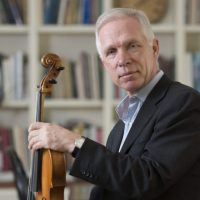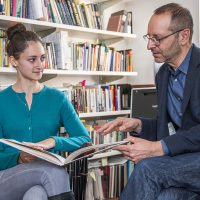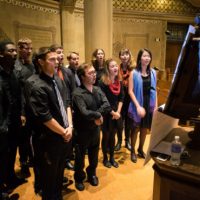Theory & Practice
Stanford launches new free online course on Beethoven
A new online course explores Ludwig van Beethoven’s music and development as a composer. The class, led by music historian Stephen Hinton, features performances by and discussions with the St. Lawrence String Quartet, Stanford's ensemble-in-residence.Composer Ludwig van Beethoven’s history, reception and evolution as an artist is the subject of a new Stanford Online course that is free and open to the public. The course, which launched in spring quarter, is designed for any level of musical literacy – from beginner to buff – with the aim of enhancing people’s understanding and…
Read MoreLiterature professor collaborates with students and artist on poetry project
Amir Eshel teaches that art is a way to react to life’s most challenging circumstances.When poet and Stanford Professor Amir Eshel saw a series of drawings in the studio of German artist Gerhard Richter, he had an experience many would describe as spiritual. Eshel was in Cologne, Germany to interview Richter for his forthcoming book Poetic Thinking Today (Stanford University Press, 2019). He wanted to learn more about the artist’s four-part…
Read MoreResisting tyranny with humor: Timely lessons from the 1500s
GREG WALKER is the Bliss Carnochan International Visitor and a professor of English literature at the University of Edinburgh in Scotland. He studies late medieval and early Tudor literature and drama. His numerous books include, most recently, Imagining Spectatorship: From the Mysteries to the Shakespearian Stage (Oxford, 2016), co-authored with John J. McGavin, and Textual Distortion: Essays and Studies (Brewer,…
Read MoreNew exhibition highlights Stanford’s connection to Pacific cultures
Items from the Pacific region gathered by Jane Stanford and faculty members are on display as part of a new exhibition at the Stanford Archaeology Center curated and installed by students under the instruction of Christina Hodge, academic curator and collections manager for archaeology collections.A Papua New Guinean mask, shell necklaces from Samoa and Hawaii, and a ceremonial club from New Zealand are among some of the antique pieces now on display in the new exhibition, Pacific Links: Currents of Material Connections, at the Stanford Archaeology Center. Video by Kurt Hickman Both undergraduate and graduate students installed and curated the materials for…
Read MoreGender-swapped play takes on the ‘men’s rights’ movement
Stanford graduate students in classics translate and adapt an ancient Greek play to lampoon a modern political movement.It’s a summer day in Sonoma Valley’s Bohemian Grove, where the country’s most powerful men gather to cavort, perform mysterious rituals and cement their social and political power. This year, however, they have a different agenda: whether to bar women from comedy and from voting. This is the premise of Men’s Rites: An Alt-Comedy, which…
Read MoreStanford musicologist brings the 15th century to life
Stanford’s Jesse Rodin reanimates musical experiences of the distant past through performance.Audiences often trust that performers know the history of the music they present, but even for the most dedicated performers there are unanswered questions. How, for instance, were ensemble performances experienced during the Renaissance? Do we experience them similarly today? For Jesse Rodin, associate professor of music, questions like these are central. “We might not…
Read MoreReimagining an African gallery
Stanford students bring new insight to a Cantor Arts Center spaceMuseums foster conversations between the work on display and its audience. To keep the conversation going, museums must change over time. Stanford’s Cantor Arts Center advanced the artistic conversation this spring when 12 undergraduates reimagined part of its African galleries in a class taught by Catherine Hale, the Phyllis Wattis Curator of the Arts of Africa and the Americas from 2014…
Read MoreNew Stanford exhibition highlights power of reinterpretation, consultation with Native American communities
The new Stanford exhibition, "From 'Curios' to Ambassadors: Changing Roles of the Daggett Collection from Tribes of the Lower Klamath River," highlights Native American tribal objects in a way that more precisely reflects their origins. It is on view through June 4, 2016.In the late 1890s, the entrepreneur and former lieutenant governor of California, John R. Daggett, assembled an ethnographic collection of objects to illustrate the lives of Hupa, Karuk and Yurok communities in Northern California. Earlier he had served as commissioner for California’s pavilion at the 1893 World’s Columbian Exposition in Chicago, where exhibits showcased material…
Read MoreNew home of the Stanford Department of Art & Art History is an adventure
The McMurtry Building at Stanford University offers new studios and classrooms for the students as well as new galleries and views for the community.“Wow” is an apt way to describe the student and community response to the new home of the Department of Art & Art History in Stanford’s arts district. The McMurtry Building was completed over the summer, opening for instruction and art-making on the first day of the fall term. Since then, students have explored 100,000…
Read MoreStanford’s newest building spotlights art and art history
Stanford's new McMurtry Building was feted by the media, the campus community and officially welcomed into the campus fold. The first new building of the academic year, McMurtry houses the Department of Art & Art History.On Oct. 6, Stanford Board of Trustees Chair Steven Denning formally accepted the McMurtry Building for theDepartment of Art & Art History. It is the first new building to open this academic year. The building dedication was one of several celebratory events on Tuesday. The McMurtry Building at Stanford University, the new home of the Department…
Read MoreStanford music scholar redefines the jazz and cabaret culture of 1920s Harlem
Musicologist Nate Sloan's investigation of Harlem Renaissance jazz portrays a diverse, multisensory experience where music, place and race influenced each other in profound and lasting ways.From 1926 to 1935, the Cotton Club was the hottest jazz hub in New York City’s vibrant Harlem neighborhood. Not only did the club launch the careers of Duke Ellington, Cab Calloway and Lena Horne, but it also attracted celebrity clientele like Jimmy Durante, Walter Winchell and even the Prince of Jordan. Owned and run…
Read MoreStanford Repertory Theater explores the ethics of science with Brecht’s Life of Galileo
Do scientists have an ethical responsibility to serve the greater good? Stanford students, professors and professional actors present Bertolt Brecht's masterful exploration of the roles of commerce, politics and religion in shaping the future of scientific research.German playwright Bertolt Brecht is considered to be one of the most influential figures in 20th-century theatre. Like so many of Brecht’s plays, the themes in Life of Galileo resonate decades after it was written. The story centers on the great Italian scientist and natural philosopher Galileo Galilei, during the period when the Roman Catholic…
Read MoreStanford literary scholar: White whales and the ‘Melville Effect’
With a resurgence of Melville-themed art across the multimedia landscape, Stanford Humanities Center Fellow Joseph Boone says the legendary writer has become a 21st-century muse for artists – including Boone himself.As the author of syllabus staples like Billy Budd, Herman Melville has been a fixture of American letters over the past century. But this hasn’t always been the case. During his lifetime, readers knew Melville for his adventure stories like Typee and Omoo, but the works we know him for today –especially Moby-Dick – sold…
Read MoreFive-year digitization and inventory project at Cantor nears the finish line
Entire collection will be online to everyone this fall, allowing scholars and the public greater access to the encyclopedic collection and presenting the Cantor staff with a clear picture of the museum's holdings.It has been picture day at Stanford’s Cantor Arts Center five days a week for five years. Thousands of objects have posed for the camera in order to be included in an online database. The massive digitization and inventory project serves multiple purposes: access for students, faculty and other scholars; a clear assessment of what…
Read MoreStanford Live expands its mission with 2015-16 season
Next season will feature three events with Anna Deavere Smith and a new work by Stanford composer Jonathan Berger for the Kronos Quartet.“The Arts and Social Change” and “War: Return and Recovery” are the two key themes at the core of Stanford Live’s 2015-16 season. The program will offer a full spectrum of classical, contemporary and multimedia performances, as well as talks, panels and seminars that build on the intellectual depth and breadth of this past season’s…
Read MoreChoices!
It’s May at Stanford and that of course means – an exciting smorgasbord of arts activities. Every weekend is packed with an abundance of arts options. Make some difficult choices – or attend them all! Here is just a sampling of what each weekend brings: May 1-3: Musical Happy Hour with Fleet Street and Chanticleer…
Read More









